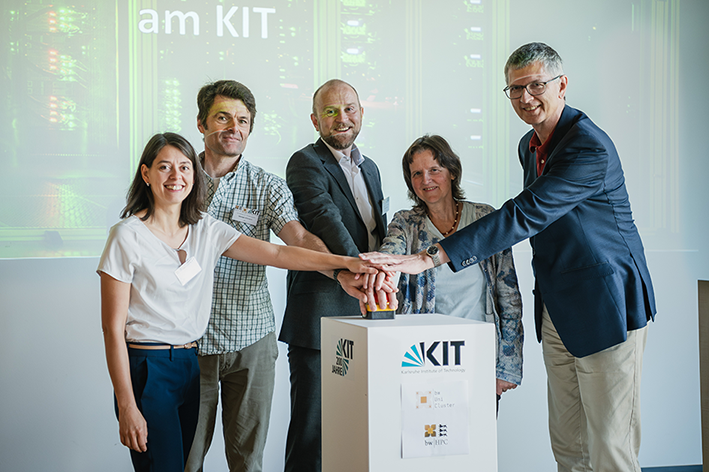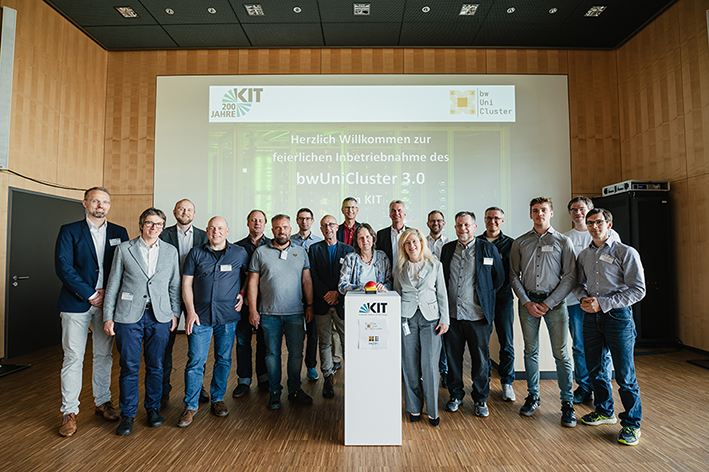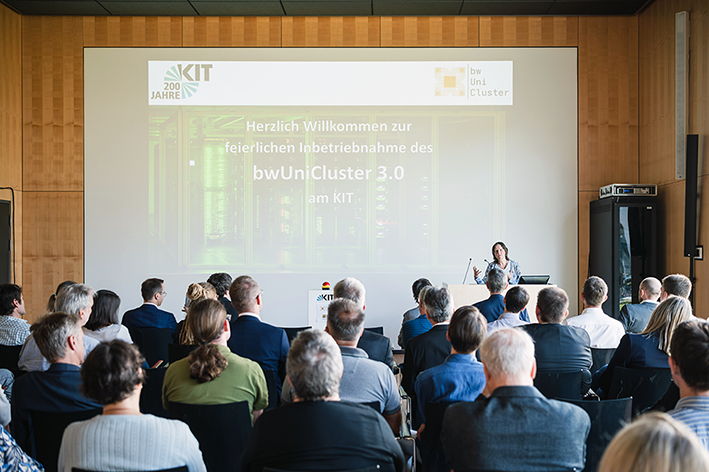Update: Commissioning of the new bwUniCluster 3.0
KIT commissions bwUniCluster 3.0
On June 23rd, 2025 the Karlsruhe Institute of Technology (KIT) put the bwUniCluster 3.0 high-performance computer officially into operation. The system is part of the state-wide "bwHPC" infrastructure. It supports data-intensive research, such as artificial intelligence and engineering, with much more computing power and storage than before.
"With the bwUniCluster 3.0, we are providing the scientific community with a powerful and sustainable tool," says Professor Martin Frank, Director of the Scientific Computing Center at KIT, which operates the supercomputer. "It opens up new opportunities for students and doctoral candidates in particular to efficiently implement data-intensive projects - from the initial idea to publication." Representatives of the Ministry of Science, Research and the Arts of Baden-Württemberg (Peter Castellaz and Oliver Roll) and Prof. Kora Kristof, KIT Vice President for Digitalization and Sustainability, attended the ceremony.
Over 27,000 computing cores for complex simulations
The cluster includes 393 compute nodes with 27,632 CPU cores and 188 GPUs. The theoretical peak performance is 8.8 PFlops/s. A typical laptop has four to eight cores. This equals roughly 3,000 to 6,000 laptops working at once, with better networking, higher energy efficiency, and hardware optimised for scientific workloads. "Thanks to the combination of modern processors (CPUs) and graphics chips (GPUs), complex simulations and AI models can be calculated in hours instead of weeks," says Martin Frank. "This is a real step forward for data-intensive research projects.“
Storage for millions of research datasets
Users have 127 TiB of storage to store and process millions of images, DNA sequences, or measurement data. Hot water cooling also improves energy efficiency. bwUniCluster 3.0 is part of the "bwHPC" initiative, which provides high-performance computing for research and teaching in Baden-Württemberg. All members of participating universities can use it, from bachelor theses to large projects.
Further information and registration:
bwHPC portal: https://www.bwhpc.de/880.php
Wiki to get started: https://wiki.bwhpc.de/e/BwUniCluster3.0
______________________________________________________________________
We are pleased to announce the commissioning of the new regional high-performance computer bwUniCluster 3.0. The new cluster will significantly expand and modernise the existing bwHPC infrastructure. It provides the universities in the state of Baden-Württemberg with basic computing power and can be used free of charge by employees of all universities in Baden-Württemberg.
Powerful expansion for science and research
The "bwUniCluster 3.0+KIT-GFA-HPC 3" adds around 90 additional computing nodes and modern, high-performance file systems for HOME and workspace areas. The expansion of the predecessor system, the Ice Lake partition of bwUniCluster 2.0 (UC2e), which went into operation in 2022, will continue to be usable. Following the current maintenance on April 14th, 2025, this partition will be fully integrated into the new cluster from next week. Therefore approx. 370 computing nodes will be available to users for their computing-intensive applications. Of these, around 90 nodes are accounted for by the new components operated at KIT Campus North, which can be operated in a more resource-efficient manner thanks to their hot water cooling and also contribute to heating the surrounding office buildings.
Access and registration made easy
Each state university regulates the access authorisation to this system for its employees itself. Users who already have access to bwUniCluster 2.0 automatically receive access to bwUniCluster 3.0. No new entitlement is required to access the new cluster. Existing bwUniCluster 2.0 user accounts are automatically upgraded to bwUniCluster 3.0. All they have to do is register for this service at bwIDM. Further details on registration and access to this national service can be found at the bwHPC Wiki.
New file systems - data migration required
The new cluster is accompanied by new file systems for HOME and Workspaces. There will be no automatic data migration from the previous system. Users are requested to transfer their data manually. A comprehensive Data Migration Guide including supporting bash scripts is available for this purpose.
The file systems and login access of the previous cluster will remain active until July, 6th 2025. Data can be transferred to bwUniCluster 3.0 during this period.
Standardisation of the user name scheme
A new user name scheme will be introduced for KIT users. In future, the cluster user name will consist of the KIT user name with the prefix ‘ka_’ - a further step towards the nationwide standardisation of the user ID.
Support and further information
If you have any questions or need support, the support team is available as usual via the bwSupportPortal.






